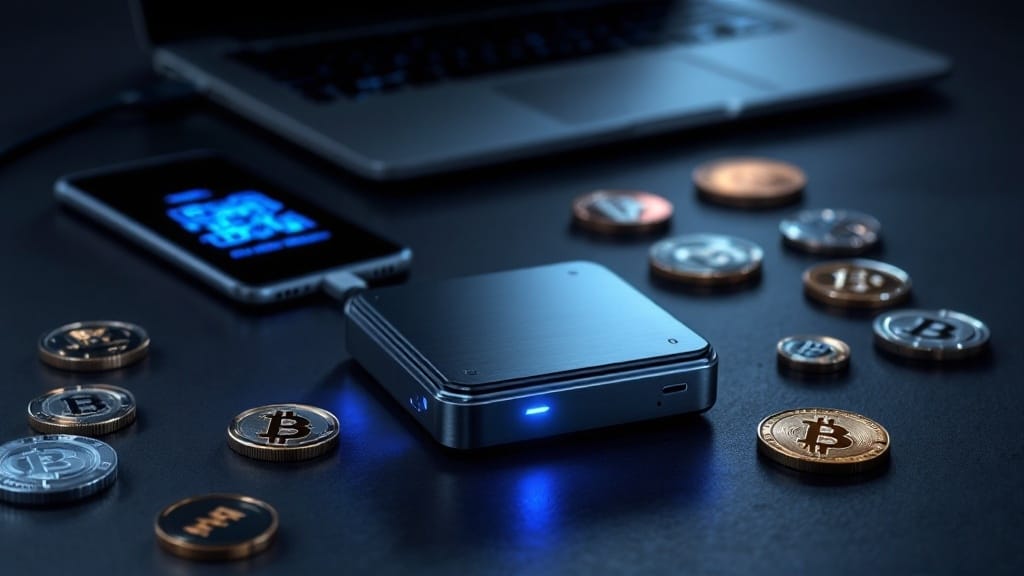Cryptocurrency wallets function as digital interfaces that enable users to manage their blockchain assets through secure public and private key pairs. These tools come in multiple forms, including custodial platforms managed by external parties and non-custodial solutions where users maintain complete control. Hot wallets provide constant online access for frequent trading, while cold storage options offer improved security through offline storage. Understanding wallet functionality reveals the full potential of digital asset management.

As cryptocurrency continues to reshape the financial landscape, crypto wallets have emerged as vital tools for managing digital assets securely and efficiently. These digital storage solutions function as interfaces that enable users to interact with blockchain networks, facilitating the sending, receiving, and monitoring of cryptocurrency holdings through sophisticated cryptographic systems. Users commonly utilize their wallet addresses for secure transactions through QR codes and alphanumeric strings.
Crypto wallets operate using a pair of cryptographic keys: a public key, which can be shared freely to receive funds, and a private key, which must be kept secure as it provides complete control over the stored assets. Users can choose between different wallet types based on their specific needs, with custodial wallets offering convenience through external management, while non-custodial options provide complete control over private keys and assets. The first cryptocurrency wallet was developed by Satoshi Nakamoto, marking the beginning of user-friendly digital asset management. The setup process involves creating a unique recovery phrase that serves as a backup for accessing funds if the wallet is lost or damaged.
Secure cryptocurrency management hinges on mastering the interplay between public and private keys while choosing wallet solutions aligned with security preferences.
The distinction between hot and cold wallets represents a fundamental consideration in cryptocurrency storage. Hot wallets, which maintain constant internet connectivity, offer convenience for frequent transactions through mobile apps, desktop software, or web interfaces, often incorporating features like NFC payments and QR code scanning.
Conversely, cold storage solutions, including hardware devices like Ledger and Trezor, provide improved security by keeping assets offline and protecting them from potential cyber threats.
Modern crypto wallets have evolved beyond simple transaction tools, now offering extensive functionality for interacting with blockchain networks. Advanced features include support for multiple cryptocurrency chains, integration with decentralized applications (dApps), and management capabilities for non-fungible tokens (NFTs).
Security measures such as two-factor authentication, encryption, and tamper-resistant hardware provide additional layers of protection for stored assets.
Selecting an appropriate crypto wallet requires careful consideration of factors such as intended usage patterns, security requirements, and supported cryptocurrencies. Users managing frequent transactions might prefer the accessibility of hot wallets, while those focusing on long-term storage of significant holdings often opt for the enhanced security of hardware or cold storage solutions.
This choice becomes increasingly significant as the cryptocurrency ecosystem continues to expand and evolve, making secure asset management a vital consideration for participants in the digital economy.
FAQs
What Happens to My Crypto if I Lose My Recovery Phrase?
Losing a recovery phrase results in permanent loss of access to cryptocurrency funds, as there is no central authority or support system that can restore access.
While the assets remain secured on the blockchain, they become effectively irretrievable without the phrase.
The funds continue to exist in the wallet address, but without the recovery phrase acting as the cryptographic master key, no transactions or withdrawals can be initiated.
Can I Store Different Types of Cryptocurrencies in One Wallet?
Multi-currency wallets enable users to store diverse cryptocurrencies in a single location, offering convenience and simplified portfolio management.
These wallets support multiple blockchain networks, allowing storage of Bitcoin, Ethereum, and other digital assets simultaneously.
When selecting a multi-currency wallet, users should consider factors such as security features, supported cryptocurrencies, and whether it’s a hot wallet (online) or cold wallet (offline storage device).
How Do I Protect My Wallet From Hackers?
Protecting a cryptocurrency wallet requires multiple security layers. Users should implement strong passwords with two-factor authentication, utilize cold storage or hardware wallets for large holdings, and enable multi-signature requirements for transactions.
Regular software updates, secure internet connections through VPNs, and maintaining offline backups are crucial. Furthermore, distributing assets across different wallets and conducting regular security audits helps mitigate potential losses from cyber attacks.
Which Crypto Wallet Has the Lowest Transaction Fees?
Among cryptocurrency wallets, those supporting Nano typically offer the lowest transaction fees due to its fee-less structure and DAG technology.
For traditional cryptocurrencies, wallets integrating Ripple (XRP) follow with approximately $0.0011 per transaction, while Bitcoin Cash (BCH) wallets maintain fees around $0.0024.
Furthermore, wallets incorporating layer-2 solutions and optimized network protocols can greatly reduce transaction costs across different cryptocurrencies.
Can I Recover My Wallet if My Device Gets Stolen?
Wallet recovery after device theft is possible if proper security measures were implemented beforehand.
Users can restore access through their seed phrase, which should be stored securely offline.
For maximum protection, implementing encryption and two-factor authentication prevents unauthorized access even if the device is compromised.
Without a backup or seed phrase, recovery becomes considerably more challenging, potentially requiring professional forensic services.









